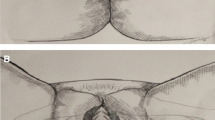Abstract
Introduction and hypothesis
Little information is available on the effects of concomitant vaginal prolapse repair on the outcomes of the transobturator tape (TOT) procedure. The purpose of this study is to assess the results and complications of TOT when combined with vaginal prolapse repair with a long-term follow-up.
Methods
We conducted a retrospective cohort study of 232 female patients who underwent the TOT procedure at two institutions. There were two groups: group 1 consisted of patients who had undergone TOT alone and group 2 consisted of patients who had undergone concomitant vaginal prolapse repair. The outcomes were analyzed considering four postoperative parameters: objective cure, subjective cure, resolution of urgency urinary incontinence (UUI), and patient satisfaction. The mean follow-up was 66.3 months (range 60–85).
Results
A total of 117 patients in group 1 and 104 patients in group 2 were documented in this study. The subjective and objective cure rates were 87.17 %, 64.95 % in group 1 and 89.42 %, 68.26 % in group 2. Patient satisfaction rates (visual analog scale [VAS] score ≥80) were 71.79 and 83.65 % in groups 1 and 2 respectively (p = 0.035). Complications were reported according to the Clavien–Dindo classification with grade I 7.7 %, grade II 69.2 %, grade IIIa 7.7 %, and grade IIIb 15.4 %, and grade I 9.5 %, grade II 47.6 %, grade IIIa 42.8 %, and grade IIIb 0 % in groups 1 and 2 respectively.
Conclusions
Concomitant vaginal prolapse repair with TOT does not have any negative effects on continence outcomes; on the contrary, it increases patient satisfaction.
Similar content being viewed by others
References
Nilsson CG, Falconer C, Rezapour M (2004) Seven-year follow-up of the tension-free vaginal tape procedure for treatment of urinary incontinence. Obstet Gynecol 104:1259–1262
Delorme E (2001) Transobturator urethral suspension: mini-invasive procedure in the treatment of stress urinary incontinence in women. Prog Urol 11:1306–1313
Taweel WA, Rabah DM (2010) Transobturator tape for female stress incontinence: follow-up after 24 months. Can Urol Assoc J 4:33–36
Tsivian A, Benjamin S, Tsivian M, Rikover M, Mogutin B, Korczak D, Sidi AA (2009) Transobturator tape procedure with and without concomitant vaginal surgery. J Urol 182:1068–1071
Stach-Lempinen B, Kujansuu E, Laippala P, Metsänoja R (2001) Visual analog scale, urinary incontinence severity score and 15D psychometric testing of three different health-related quality-of-life instruments for urinary incontinent women. Scand J Urol Nephrol 35:476–483
Giberti C, Gallo F, Cortese P, Schenone M (2007) Transobturator tape for treatment of female stress urinary incontinence: objective and subjective results after a mean follow-up of 2 years. Urology 69:703–707
Serati M, Ghezzi F, Cattoni E, Braga A, Siesto G, Torella M, Cromi A, Vitobello D, Salvatore S (2012) Tension-free vaginal tape for the treatment of urodynamic stress incontinence: efficacy and adverse effects at 10-year follow-up. Eur Urol 61:939–946
Olsen AL, Smith VJ, Bergstrom JO, Colling JC, Clark AL (1997) Epidemiology of surgically managed pelvic organ prolapse and urinary incontinence. Obstet Gynecol 89:501–506
Anger JT, Litwin MS, Qin W, Pashos CL, Rodríguez LV (2008) The effect of concomitant prolapse repair on sling outcomes. J Urol 180:1003–1006
Porena M, Costantini E, Frea B, Giannantoni A, Ranzoni S, Mearini L, Bini V, Kocjancic E (2007) Tension-free vaginal tape versus transobturator tape as a surgery for stress urinary incontinence: results of a multicentre randomised trial. Eur Urol 52:1481–1490
Stanford EJ, Paraiso MF (2008) A comprehensive review of suburethral sling procedure complications. J Minim Invasive Gynecol 15(2):132–145
Schraffordt Koops SE, Bisseling TM, van Brummen HJ, Heintz AP, Vervest HA (2007) Result of the tension-free vaginal tape in patients with concomitant prolapse surgery: a 2-year follow-up study. An analysis from the Netherlands TVT database. Int Urogynecol J Pelvic Floor Dysfunct 18(4):437–442
Wolter CE, Kaufman MR, Duffy JW, Scarpero HM, Dmochowski RR (2011) Mixed incontinence and cystocele: postoperative urge symptoms are not predicted by preoperative urodynamics. Int Urogynecol J 22:321–325
Frederick RW, Leach GE (2005) Cadaveric prolapse repair with sling: intermediate outcomes with 6 months to 5 years of followup. J Urol 173(4):1229–1233
Foster RT Sr, Barber MD, Parasio MF, Walters MD, Weidner AC, Amundsen CL (2007) A prospective assessment of overactive bladder symptoms in a cohort of elderly women who underwent transvaginal surgery for advanced pelvic organ prolapse. Am J Obstet Gynecol 197(1):82 e1–e4
Partoll LM (2002) Efficacy of tension-free vaginal tape with other pelvic reconstructive Surgery. Am J Obstet Gynecol 186:1292–1295
Jomaa M (2001) Combined tension-free vaginal tape and prolapse repair under local anesthesia in patients with symptoms of both urinary incontinence and prolapse. Gynecol Obstet Investig 51:184–186
Ballert KN, Biggs G, Isenalumhe A, Rosenblum N, Nitti VW (2009) Managing the urethra at the time of transvaginal pelvic organ prolapse repair: a urodynamic approach. J Urol 181:679–684
Sokol AI, Jelovsek JE, Walters MD, Paraiso MF, Barber MD (2005) Incidence and predictors of prolonged urinary retention after TVT with and without concurrent prolapse surgery. Am J Obstet Gynecol 192:1537–1543
Reich A, Kohorst F, Kreienberg R, Flock F (2011) Long-term results of the tension-free vaginal tape procedure in an unselected group: a 7-year follow-up study. Urology 78(4):774–777
Juanos JL, Sanchez EB, Soler JP, Mestre-Costa M, Ribot-Luna L, Vizcaíno MA (2011) De novo urgency after tension-free vaginal tape versus transobturator tape procedure for stress urinary incontinence. Eur J Obstet Gynecol 155:229–232
Daneshgari F, Kong W, Swartz M (2008) Complications of mid urethral slings: Important outcomes for future clinical trials. J Urol 180:1890–1897
Conflicts of interest
None.
Author information
Authors and Affiliations
Corresponding author
Rights and permissions
About this article
Cite this article
Yonguc, T., Gunlusoy, B., Arslan, B. et al. Does concomitant vaginal prolapse repair affect the outcomes of the transobturator tape procedure in the long term?. Int Urogynecol J 25, 1419–1423 (2014). https://doi.org/10.1007/s00192-014-2392-z
Received:
Accepted:
Published:
Issue Date:
DOI: https://doi.org/10.1007/s00192-014-2392-z




